Yeay! I'm excited that you are relearning the violin.
I started playing violin when I was 8 and my teacher put small round stickers on the fingerboard to show finger placement locations. This is very helpful.
I actually still use a similar method because when playing in an orchestra I sometimes can't hear myself over all the other instruments, and so having a visual/touch method to check if my finger is in the right place (when going into position) gives me more confidence that I'm hitting the correct note. I use thin strips (around 1/8th inch wide) of black tape stretched over the whole span of the fingerboard to show where I place my first finger when in 3rd position, and then every 2 whole step notes up from that.
Using small dot stickers on actual note positions while in first position might be useful for you as a start. An option would be Avery Removable Color Coding Labels, 1/4th inch round. I also checked online and see that companies produce strips you can use, designed to mark specific positions:
http://www.music123.com/product/Fing...473035.product
I recommend you use the chart below to place dots on the natural (non-sharped, non-flatted) notes that are part of first position and then add additional dots higher up on the fingerboard to help with shifting. You can use your ear and a tuner to help you find the correct note (while plucking the string), and then slip the sticky dot in underneath. As I mentioned before, instead of using dots I place a strip of black (electrical) tape across the whole neck of the violin (perpendicular to the fingerboard) so that the tape lies over the following notes on the E string (going up from Open E): A, C, E, G. This allows me to shift upward in two-note increments easily (at least on the E and A strings).
Once you get used to where your fingers go to hit notes, you can remove sticky dots, leaving perhaps just dots where you place your 3rd finger when in first position...C (on the G string), G (on the D string), D (on the A string), and A (on the E string)...and also a dot on every 2 whole steps up from that (on the E string this would mean the notes C, E, and G). I like to know where to go on the E string to get into different positions, because once in them I can use my ear to find desired notes on the lower strings without needing dots on those strings.
However, note that you should actually be LISTENING rather than relying on stickers to find the notes. The stickers can serve as a useful guide at the beginning, but should never replace listening to the notes to find them and adjust your finger placement.
I hope this makes sense and helps!





 Linear Mode
Linear Mode
